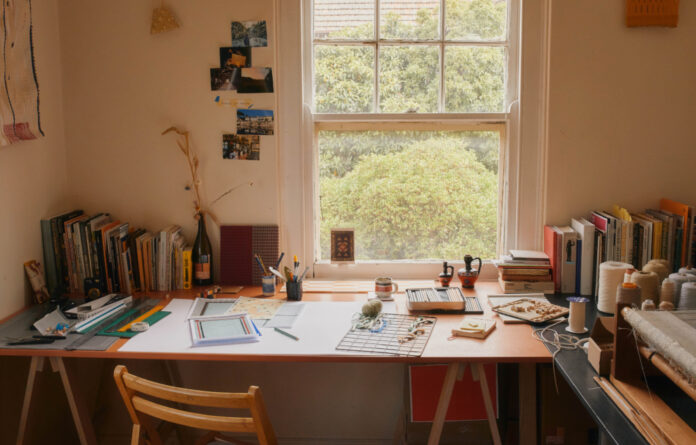This Melbourne Artist Creates Beautiful Weavings Inspired By The Past
Studio Visit

Inside the Melbourne studio of visual artist Jacqueline Stojanović.

Inspirations, books, and memories are scattered around the space.

Jacqueline’s works have been showcased in exhibitions worldwide, and a special a series of works she made in collaboration with John Nixon have even been acquired by the National Gallery of Victoria.

‘I now keep four different types of looms in my studio in Melbourne.’

Each loom was gifted to her by older weavers and artists.

One of Jacqueline’s beautiful handwoven pieces.

The weavings can take anywhere between two days to two months to complete depending on the style and size.

‘I like to experiment with many hand manipulation techniques and also bend the rules of these a little to find out how malleable they can be,’ she says of her process.

Jacqueline carefully blends single threads to create depth of colour and variation.

She also creates weavings off the loom by hand, using steel frames.

She says working on shaft looms for the floor or table, or Jacquard or digital looms requires more forward planning than weaving by hand — while tapestry feels more intuitive, ‘like a painting or picture’.

A collection of her pencil drawings.

Works left to right: ‘Untitled (portrait)’, ‘Azbuka rug’, ‘Grid IX’. Photo – Christo Crocker
For Jacqueline Stojanović, weaving is both ‘an ancient carrier of culture, and an important tool for the future’.
The Melbourne-based artist studied fine arts at Monash University before graduating with honours at the Victorian College of the Arts in 2015. ‘I was always drawn to the expansive nature of textiles, however I was encouraged to try other mediums during my years studying,’ Jacqueline says.
Outside of the classroom though, she continued to weave by hand, making small sculptures and flat woven pieces using wool and raffia. But it really all clicked when her mentor, the late abstract artist John Nixon, gave her a handheld children’s loom that had been sitting in his studio.
‘I became obsessed by the seemingly endless possibilities of woven structures on that loom, and this impulse led me on a path to discover more,’ Jacqueline adds.
She began researching the history of woven textiles from around the world, including from regions like the Caucasus, Middle East, Eastern Europe, Italy, and Iceland. With Serbian and French-Vietnamese heritage herself, Jacqueline also looked to a handweaving town in Serbia, where just six women continue the practice of traditional carpet making — down dramatically from more than 1800 just 50 years ago.
‘I’m very much interested in collective memory and the past generally,’ Jacqueline says.
‘Weaving is by process a meditative medium, and requires a great deal of time performing very repetitive motions, while I’m weaving, I often think about history, both personal and broader shared histories.’
These stories all come to life in her pieces, which can which take anywhere between two days to two months to complete. She often works using one of the four looms she keeps in her Melbourne studio (all gifted to her by older artists and weavers), creating patterned hangings and fabric ‘paintings’, or, she weaves bright threads across steel-grid frames in geometric shapes.
The intriguing detail of her work reveals how every step is intentional, from the careful blend of colours, to the texture and the number of threads she uses. And all these tiny decisions combine to create something that’s equal parts masterful in technique, and meaningful in story.
Want to see more from The Design Files? Sign up to our newsletter for your daily or weekly dose of home and design inspiration!
thedesignfiles.wpenginepowered.com










